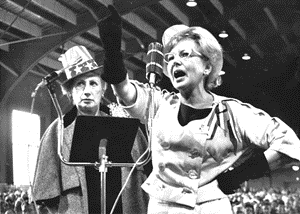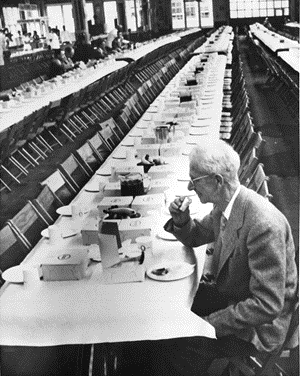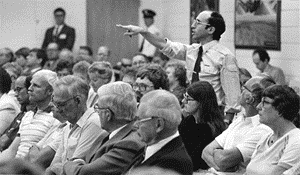
Shareholder Meetings: Unearthing the history
By Tanya Mohn
|

Wilma Soss, president of the Federation of Women Shareholders asks a
question at the General Electric annual meeting in 1962. Beatrice Kelekian
is on the left.
|
|
Nearly 400 years ago, angry shareholders of the Dutch East India
Company pushed for more rights and accused directors of self-dealing. In 19th
century America, stockholders kept a close watch on public companies that
operated bridges, canals, banks and especially railroads, which resulted in
numerous fights for control.
Not much more is known about the early days of shareholder
activity, says Colleen Dunlavy, a professor in the Department of History at the
University of Wisconsin-Madison. There is a dearth of documentation, including
in companies’ archives.
But there were two key institutional developments in this
country. “One of the big changes over the 19th century was the increasing use of
proxies and the corresponding decline in in-person attendance at shareholder
meetings,” says Dunlavy, whose research focuses on the history of shareholder
voting rights.
Attendance — and therefore in-person voting — was more robust
before the Civil War. The voting model for business corporations was based on
municipal corporations, according to Dunlavy. City residents could not vote by
proxy, and neither could early shareholders without explicit sanction in law.
Voting by proxy became common after the Civil War, as more companies expanded
their geographical reach, although some railroads in the 1850s offered free
passes to shareholders to make it easier and less costly to attend, she says.
A second significant modification was the move to cumulative
voting, a system that fosters consolidation of votes for better representation.
If a shareholder has 100 shares and three directors are being elected, the
shareholder — instead of casting 100 votes for each director — may cast all 300
votes for a single director. “By the 1880s, one vote per share was the norm in
the U.S.,” Dunlavy said. “Cumulative voting was a modest effort to counteract
the dominance of the largest shareholders and push the balance of power back to
the small shareholder.”
But it is the last century that has been the most turbulent
period for corporate oversight and power struggles between management and
shareholders, says Jeff Gramm, author of Dear Chairman: Boardroom Battles and
the Rise of Shareholder Activism, which chronicles the evolution of
shareholder behavior, highlighted by letters from activist investors like Warren
Buffett and Ross Perot. “If no one is paying attention, most boards will act in
self-preservation rather than doing right by shareholders,” he says.
A letter written in 1927 by Benjamin Graham, a professional
investor, aimed to convince John D. Rockefeller Jr., Northern Pipeline’s biggest
shareholder at the time, to distribute the company’s excess capital to
shareholders. “The letter ultimately failed,” as Rockefeller did not support
Graham’s request, “but he still won the vote,” says Gramm, a move he credits as
the birth of modern shareholder activism.
| |

Robert G. Wood of Middletown, N.Y., beats the others attending the annual
shareholders meeting for Standard Oil Company for a boxed lunch including
fruit, ice cream and coffee.
|
“For most of history, including now, most annual shareholder
meetings were uneventful formalities. But they take on a special meaning when a
company is doing very poorly,” said Gramm. “If there is no accountability, bad
things can happen.”
Shareholders and their meetings in the 1920s were made up mainly
of founding partners and strategic investors. It was a group that tended to be
engaged. Only the largest railroad companies had diverse shareholder bases.
The first modern public corporations in the United States became
recognized in the 1930s, following the great stock market crash of October 1929,
explains Alexandra Lajoux, chief knowledge officer emeritus for the National
Association of Corporate Directors. In their 1932 book The Modern Corporation
and Private Property, Adolf Berle and Gardiner Means noted with alarm a
separation of ownership and control in some companies due to dispersion of
holdings among many owners, and flagged such corporations as “quasi-public,” in
contrast to private companies.
Rules for such “public” entities became enshrined in the
Securities Act of 1933 and Securities Exchange Act of 1934, which jointly
established the Securities and Exchange Commission, says Lajoux. The main focus
of the securities laws and the SEC was to ensure proper communications from
companies to shareholders and the annual meeting was an important venue for this
transfer of information.
Section 14 of the Securities Exchange Act, she points out, is
entitled Proxies and it regulates annual communications from companies to
shareholders in the proxy statement, so named because it enables votes (via
proxy) by shareholders who are not at the meeting in person.
“While annual meetings existed before then,” she adds, “the 1934
act and its Section 14 brought discipline to the communications leading up to
the annual meeting.” Another milestone occurred in the 1940s, when the SEC
passed its first rules mandating inclusion of shareholder resolutions in proxy
statements.
By the 1950s, the shareholder base of public companies had
rapidly diffused. That decade saw a proxy fight movement, which put hostile
shareholders in the public eye for the first time. From the 1960s and continuing
until today has been a second period of concentrated ownership, this time by
large institutional investors, like pension and mutual funds.
|

Frank Shansky, a member of United Auto Workers Local 248, asks David S.
Scott, chairman of Allis-Chalmers Corp., "How do you sleep at night?"
|
|
An October 8, 1966 column from The New Yorker provides
insight into the time period. John Brooks detailed his experiences attending a
number of annual meetings, including one held by AT& T, then the world’s largest
company, in “A Reporter at Large: Stockholder Season.” Brooks, who referred to
corporate power as making the medieval feudal system look like a Sunday school
party, noted that many companies were beginning to hold the yearly gatherings
away from headquarters, officially, they claimed, to make it easier for
stockholders from other areas of the country to attend. But the real reason,
Brooks surmised, was so management could avoid “most of the noisiest dissident
stockholders.”
Meetings and shareholder involvement was very hands-off until the
1980s, a period of corporate exploitation during which hostile raiders and
management teams sometimes took advantage rather than protected the interests of
passive investors, says Gramm, the author who runs the Bandera Partners hedge
fund. “Shareholder actions during that time pushed big institutions to really
mind their business again.”
But despite notable discord through the years, the fundamentals
of annual shareholder meetings have changed little since becoming part of the
American corporate fabric and remain true to their Roman-inspired heritage.
“It’s a representative democracy,” an important check and balance
between those who run the company day-to-day and investors, says Wei Jiang, a
professor in the finance and economics division and vice dean for curriculum and
instruction at Columbia Business School. “It’s practically the only opportunity
for managers to meet shareholders face to face.”
And the combination of annual meetings and shareholder activism
“is a good thing” says Jiang, spawning engagement that challenges companies “to
act in their own best interests.”
Tanya Mohn
frequently writes about business topics, from personal finance issues to the
changing workplace, for a host of publications including
The New York Times, Forbes, BBC and NBC
News.
| © 2017
Directors & Boards. All rights reserved. |
|